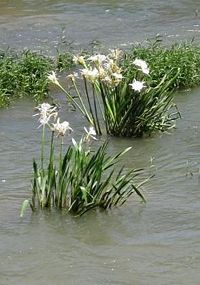Cahaba lily: Difference between revisions
No edit summary |
No edit summary |
||
| (6 intermediate revisions by 2 users not shown) | |||
| Line 1: | Line 1: | ||
The '''Cahaba lily''' (''Hymenocallis coronaria'') is a type of spider lily native to sunny, fast-flowing shoals in the [[Cahaba River|Cahaba]], [[Black Warrior River|Black Warrior]], [[Coosa River|Coosa]], [[Tallapoosa River|Tallapoosa]] and [[Chattahoochie River]] systems in Alabama and to a few rivers in Georgia and South Carolina. | [[Image:Cahabalilies.jpg|right|200px|thumb|Cahaba lilies on the Cahaba River, May 2009]] | ||
The '''Cahaba lily''' (''Hymenocallis coronaria'') is a type of spider lily native to sunny, fast-flowing shoals in the [[Cahaba River|Cahaba]], [[Black Warrior River|Black Warrior]], [[Coosa River|Coosa]], [[Tallapoosa River|Tallapoosa]] and [[Chattahoochie River]] systems in Alabama and to a few rivers in Georgia and South Carolina. There are currently 70 documented populations of the plant, of which 46 are in Alabama. | |||
The flower, which appears from mid-May to mid-June, is white, crown-shaped and approximately 3 inches in diameter. New blooms appear daily and are pollinated by [[Plebeian sphinx moth]]s and [[Pipevine swallowtail]]s. Once germinated, new seeds drop into the water where they form bulbs and lodge between rocks, ready to send up leaves and flowering shoots the next April. | The aromatic flower, which appears from mid-May to mid-June, is white, crown-shaped and approximately 3 inches in diameter. New blooms appear daily and are pollinated by [[Plebeian sphinx moth]]s and [[Pipevine swallowtail]]s. Once germinated, new seeds drop into the water where they form bulbs and lodge between rocks, ready to send up leaves and flowering shoots the next April. | ||
Because the Cahaba lily's habitat is restricted to shallow, free-flowing shoals it has been threatened by the damming of large rivers for hydroelectric power as well as by silt and deposits from mining, industry and construction. | Because the Cahaba lily's habitat is restricted to shallow, free-flowing shoals it has been threatened by the damming of large rivers for hydroelectric power as well as by silt and deposits from mining, industry and construction. | ||
==References== | ==References== | ||
* Davenport, L. J. (January 30, 2007) "[http://www.encyclopediaofalabama.org/ | * Davenport, L. J. (January 30, 2007) "[http://www.encyclopediaofalabama.org/face/Article.jsp?id=h-967 Cahaba Lily]" ''Encyclopedia of Alabama'' beta version - accessed July 10, 2007 | ||
* Velasco, Anna (June 1, 2008) "A Cahaba lily by any other name would smell so sweet." ''Birmingham News'' | |||
[[Category: | [[Category:Wildflowers]] | ||
[[Category:Threatened species]] | [[Category:Threatened species]] | ||
[[Category:Native plants]] | |||
[[Category:Cahaba River]] | [[Category:Cahaba River]] | ||
Latest revision as of 17:32, 14 March 2011
The Cahaba lily (Hymenocallis coronaria) is a type of spider lily native to sunny, fast-flowing shoals in the Cahaba, Black Warrior, Coosa, Tallapoosa and Chattahoochie River systems in Alabama and to a few rivers in Georgia and South Carolina. There are currently 70 documented populations of the plant, of which 46 are in Alabama.
The aromatic flower, which appears from mid-May to mid-June, is white, crown-shaped and approximately 3 inches in diameter. New blooms appear daily and are pollinated by Plebeian sphinx moths and Pipevine swallowtails. Once germinated, new seeds drop into the water where they form bulbs and lodge between rocks, ready to send up leaves and flowering shoots the next April.
Because the Cahaba lily's habitat is restricted to shallow, free-flowing shoals it has been threatened by the damming of large rivers for hydroelectric power as well as by silt and deposits from mining, industry and construction.
References
- Davenport, L. J. (January 30, 2007) "Cahaba Lily" Encyclopedia of Alabama beta version - accessed July 10, 2007
- Velasco, Anna (June 1, 2008) "A Cahaba lily by any other name would smell so sweet." Birmingham News
